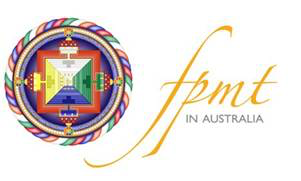

..nestled amongst the breathtaking scenery of the Himalayas. Follow in the footsteps of Guru Padmasambhava and other Buddhist saints as we journey to ancient monasteries, lakes, hidden landscapes and holy places.
We are guided by renowned Buddhist Master, Geshe Tenzin Zopa, who inspires us with his teachings and will lead us in sacred rituals and practice. This is a rare and life-changing opportunity for spiritual transformation, particularly as we will celebrate the holy day of Saka Dawa during our pilgrimage. We ensure that there is space in the program for quiet individual contemplation and meditation.
Registrations are now open with a $AU190 deposit due to save your place. Only a few places left.
Don’t miss out. More details below.

Geshe Tenzin Zopa holds the honoured Geshe (Doctorate) degree from Sera Jey Monastic University, South India. He was ordained at the age of 9 at Kopan Monastery by the late great mahasiddha Geshe Lama Konchog. Under the direct tutelage of Kyabje Lama Zopa Rinpoche and Geshe Lama Konchog, Geshe Tenzin Zopa has received myriad transmissions and possesses vast scriptural knowledge. He has successfully managed major humanitarian projects, completed many major retreats and is highly skilled in rituals, astrological observations, and religious dance. He has taught at Oxford University (UK), is on the board of Foundation for the Development of Compassion and Wisdom and is an international travelling geshe for the Foundation for the Preservation of the Mahayana Tradition.
June 1st to 17th
DAY 1 Arrive Delhi. Welcome dinner with Geshe Tenzin Zopa
DAY 2 Fly to Leh, Ladakh. Arrive 11am. Rest & acclimatise afternoon.
DAY 3 Leh Palace, Museum & Namgyal Tsemo Monastery
DAY 4 Visit Shey & Thiksey Monasteries, Shey Palace
DAY 5 Visit Hemis Monastery
DAY 6 Visit TakThok Monastery & Chemday Monastery
DAY 7 Indus Valley Tour – Stakna, Matho & Stok Monastery
DAY 8 Drive to Likir, Alchi Monastery complex, Temisgam
DAY 9 Lamayuru Monastery & village, Tenisgam
DAY 10 Rizong & Mangu Monasteries. Drive to Leh
DAY 11 Nubra Valley.
DAY 12 Day trip to Turtuk
DAY 13 Drive to Pangong Tso lake via Warila/Shayok
DAY 14 Drive Pangong to Leh
DAY 15 Free day at Leh
DAY 16 Fly to Delhi. Thank you dinner with Geshe Zopa and friends
DAY 17 Depart Delhi after breakfast
Detailed itinerary at bottom of page
17 days and 16 nights
Flights Delhi-Leh-Delhi included
US $4,053 per person twin share
AU $5,980 per person twin share
US $350 single person supplement
AU $518 single person supplement
Non-refundable deposit of $AU190 due now to register
Discount for one FPMT sangha of 20% is offered
Airport pick up at Delhi
Transport to Delhi hotel from airport
Flights Delhi -Leh – Delhi
Twin Share en-suite 3 – 4 star accommodation in Ladakh in unique and comfortable hotels and tea-houses
5 star accommodation in Delhi overnight 16th June
All meals, tea, coffee, snacks in Delhi & Ladakh
All monastery entry fees
Offering to Geshe Tenzin Zopa
Offerings to monks and nuns
Transport by mini-bus/car/jeep in Ladakh
Bottled Drinking water
Three experienced guides/ logistics team
One pilgrimage support coordinator
Group tip for porters, drivers etc
Tea & cakes offering to children at Ngari Institute
Presents for children at Ngari Institute
Cash Offering to Ngari Institute, Leh
International airfares (you are responsible for getting to Delhi)
Travel & cancellation insurance
Indian Tourist e-Visa
Additional donations to monasteries and projects in Ladakh
Medicines
Personal items such as laundry
Personal tips for guides, porters, drivers etc.
Transport to Delhi airport at finish of pilgrimage
Ladakh has a long and rich history of Buddhism, even predating Buddhism’s movement into Tibet. Emperor Ashoka sent Buddhist missionaries into present-day Ladakh in the 2nd century BCE, where it gained even more traction in the 1st and 2nd centuries CE. It established itself as an independent country in the middle of the 10th century,
We will visit caves where Guru Padmasambhava meditated, places where he battled demons abd left his footprints, shrines and stupas built by other Buddhist saints and kings and immerse our minds in the holiness of these places.
Ladakh is situated on the Tibetan Plateau and we will be travelling at altitude. FPMTA and the Three Jewels Treeking and Climbing guides understand the importance of safety. Many of the places we’ll be visiting have steps so we take them slowly, and at times we will travel at quite high altitudes. Pilgrims should follow the advice of our experienced guides and the pilgrimage coordinator at all times, especailly regarding acclimatisation.
Once your place is reserved we will send you full details on doing pilgrimage in Ladakh at altitude, common sense steps to managing your wellbeing and dealing with altitude sickness etc.
Registrations are now open.
An initial non-refundable deposit of AU $190 is due to save your place. A further amount of AU $2,000 is then due by 15th October.The remainder of the fee is due by Friday 28th February 2025. *The USD conversion rate to AUD is .6350 as at 24/5/2024. The conversion rate will be adjusted when full payment is due on 28/02/2025.
At the time of registration we ask that you complete a detailed questionnaire which includes medical questions. As a duty of care we may follow up your application and request further information from your physician.



Our itinerary from 1st to 17th June
You will be picked up from the airport and driven to the hotel. We will have a welcome dinner with Geshe Tenzin Zopa where we will meet other pilgrims, the support team from Three Jewels Adventures and the FPMTA pilgrimage coordinator, Stephie.
Leh is the capitol of Ladakh and is located on the edge of the Tibetan plateau at an altitude of 3,524 m/11,562 ft. It has a population of around 30,800 people. The ancient kingdom of Ladakh had its seat in Leh at Leh Palace which was built at the same time as the Potala Palace in Tibet. Today we acclimatise to the altitude, relax, do practice and prayers together with Geshela, and enjoy the views from Leh.
The Leh Palace is nine stories high and overlooks the city. It is mainly in ruins, however the Palace Museum that is based there, holds a collection of beautiful thangkas, ceremonial dress, and ornaments salvaged from the palace. Around the palace base is the Namgyal Stupa and the Chandazik Gompa. Nearby is the Namgyal Tsemo monastery complex, founded in 1430, where an 8-metre-high statue of the Maitreya Buddha can be found.
The Shey Monastery, which houses a 12-meter-tall copper statue gilded with gold of Shakyamuni Buddha, is part of the Shey palace complex, built as a summer residence by the first king of Ladakh in the 17th century. The palace is known for its beautiful architecture and impressive collection of Tibetan and Buddhist art, including murals, paintings, and statues.
The monastery of Thiksey stands out for its sheer size – and its resemblance to the Potala in Lhasa. The monastery houses a 15-metre-high statue of Maitreya Buddha in a double-height shrine room and ancient Buddhist frescoes, including one of White Tara that is centuries old.
Hemis Monastery was built in 1620 by the king Singe Namgyal who was a great patron of Buddhism. He filled Hemis with golden statues, stupas set with precious stones and thankhas brought from many places including Tibet. The history of Hemis Monastery states that it is considered to have existed before the 11h century. The monastery of Hemis is connected with Naropa, the pupil of the yogi Tilopa, and teacher of the translator Marpa. It is believed that Naropa and yogi Tilopa met at Hemis. Hemis Monastery is the main seat of the Kagyu lineage of Buddhism.
The TakThok gompa houses about 55 lamas of the Nyingma-pa sect. Members of this lineage are followers of Padmasambhava’s (Guru Rinpoche’s) teachings and TakThok is the only gompa in Ladakh that is Nyingma-pa. Hewn into the cliff is the cave where Padmasambhava meditated. We will undertake a Guru Rinpoche puja here with offerings.
Chemday Monastery is located on the hill above Chemday village and was founded 400 years ago. It has a well-known and beautiful one-story painting of Guru Rinpoche along with many special shrines. The Buddhist art and buildings have been very well-preserved and are the subject of a government restoration project.
These monasteries are close to each other on the south side of the Indus River. Stakna monastery was founded around 1580 and is known as Tiger’s Nose. It follows the Drukpa Kagyu lineage and emphasises the profound meditation practice of Mahamudra. It is known for its stunning architecture and picturesque location.
We also visit Matho monastery in the Stok mountains, which dates from 1410 and is the only monastery in Ladakh belonging to the Sakya lineage. It houses the largest thangka collection in the world. Matho is most famous for its oracles, which are a big draw during the annual Nagrang festival held in late winter.
Stok Monastery is 550 years old and is of the Gelukpa lineage. The gompa and shrine rooms feature many images of Buddhist protectors and deities and there is an impressive library. A statue of Gautama Buddha stands some 71 feet and there are also beautiful newly painted religious murals.
Likir Monastery is located about 56 km from Leh in Likir village in the Sham Valley. Its inception dates back to around 1065 and it has a 23-metre-high statue of Maitreya Buddha, covered in gold. Inside the wall inscriptions indicate its ancient origins. It is surrounded by old chortens and barley fields. The hill on which the monastery stands was long thought to be the resting place of nagas. The name Likir in fact is a corruption of the work lu-khil, meaning ‘snake coiled’ or ‘snake encircled’. The monastery follows the Gelukpa lineage and it currently houses around 120 monks and runs a school for the children of nearby villages. Likir monastery is the seat of Ngari Rinpoche, who is the younger brother of the Dalai Lama.
Alchi Monastery is located near the small village of Saspol. It is one of the earliest monasteries built in Ladakh, dating from the 11th century. It is famous for its interior murals and ancient wood sculptures, which are some of the best examples of Ladakh’s Indo-Tibetan art. The monasteries in Alchi are said to have been established by the great translator from Tibet, Lotsawa Rinchen Zangpo. The wall paintings reflect influences of both the Buddhist and Hindu kings from Kashmir and Himachal Pradesh. For instance, Mahakala is adapted from the Hindu god Shiva.
Temisgam’s Monastery is of the Kagyu lineage, which is situated in the picturesque village of Temisgam. Its structures are adorned with colourful frescoes, murals and intricate woodwork. We will be staying for two nights here at Temisgam whilst we explore the surrounding area.
The mystical and lunar-like landscape of Lamayuru is located about 100 km west of Leh. This Drikung-school temple with its red and white buildings is home to around 150 monks. It is perched high above its village and the oldest part of the monastery dates from the 11th century. Legend has it that at the time of Shakyamuni Buddha, the monastery used to be situated under a big lake, home to many nagas. The Arhart Madhyantika made water offerings to the nagas and with his walking staff, made a leak for the water which trickled out leaving the moon-like craters. Preserved in the monastery is the cave where Naropa (1016 – 1100) underwent strict retreat, as well as five temples built by the great translator Rinchen Zangpa (985 – 1055), one which is in perfect condition. We spend another night in Temisgam.
The setting for Temisgam Gompa is quite spectacular and atmospheric. It houses a special shrine room for Padmasambhava and consorts, with fine paintings on the walls.
The Rizomg monastery was established in 1831 by Lama Tsultim Nima. The monastery is also called “the paradise for meditation” and is noted for its extremely strict rules and standards. There is an attached nunnery, located about 2 km from the monastery, called the Jelichun Nunnery or Chulichan (Chomoling), where, at present, 20 nuns reside.Guru Padmasambhava is said to have meditated in the caves around Rizong, years before the monasteries were built. In the small caves in the vicinity, lamas used to meditate for years in isolation from the rest of the villages. They subsisted on one meal a day, which was provided to them by local people through a small square window opening in the cave. Over the years, the hermitage became a place of worship and pilgrimage to all Buddhists from Ladakh. It is reported that the king of Ladakh gave rich donations to convert the Hermitage into a retreat center and the queen of Ladakh even visited this place on a pilgrimage.
The small village of Mangu is adjacent to Alchi, and has the same landscape of poplars and apricot trees. The Mangu monastery consists of similar architechure to the Alchi Monastery complex and was also founded by Lotsawa Rinchen Zangpo. It is situated on a flat landscape rather than on the top of a hill like other monasteries monasteries who did so to guard against marauders. Mangu monastery consists mainly of four temples.
Known for its orchards, scenic vistas, Bactrian camels and monasteries, Nubra Valley is the northernmost part of Jammu and Kashmir. Situated about 150 km from Leh, Nubra Valley is known as the Orchard of Ladakh and was originally called Ldumra which meant the valley of flowers. Nubra Valley is also renowned for its sacred mountains, lakes and waterfalls (and an ancient juniper tree) which have been places of pilgrimage for centuries.To reach Nubra valley, we cross the awe-inspiring Khardung La, the highest motorable pass in the world at an altitude of 18,380 ft/5,602 m. Winding channels of the Shyok and Nubra Rivers criss-cross the wide and flat Nubra valley. Nubra lies at average altitude about 10,000 ft/3,050m above sea level. The steep walls of the head of the valley are dissected by desert and the milky green waters of the Shyok River, only giving way to the green oasis of an occasional settlement.
If we are lucky we will see the famous double-humped Bactrian camels. Diskit Monastery has 33m statue of Maitreya Buddha facing down the Shayok river.
Turtuk is the last northernmost out-post of India at Thang after which Pakistan-controlled Gilgit-Baltistan begins. It was part of the Silk Road trading route and is home to around 4,000 people of mainly Muslim ethnicity. The village was once a part of Pakistan and was only opened to tourists in 2010. As such, it has retained its originality and authenticity. The road to Turtuk Village has scenic landscapes and crosses the Shyok River. The region is renowned for its apricot orchards, terraced fields and ancient monasteries. Turtuk is surrounded by stunning landscapes.
Wari La Pass is famous for its breathtaking view from the road and the road is thrilling to drive. The altitude of Wari la Pass is 5,312 meters (17,427 feet) above sea level.
The Shyok Valley is the valley of the Shyok River — the river of death. This is a ‘Yarkandi’(Central Asian) name, probably given by the Central Asian traders who ventured on this treacherous route for centuries and perished. Shyok is a small village located on the banks of the Shyok River in Nubra Valley. It is situated at an elevation of 3,700 meters (12,100 feet) and is the last village on the Indian side of the road to Daulat Beg Oldie (DBO), a military base near the India-China border.
Shyok is a remote village with only a few hundred inhabitants. It is a popular destination for tourists looking for an offbeat experience. The village is surrounded by stunning scenery, including the Karakoram Mountains, the Shyok River, and the vast Nubra Valley.
The Pangong Tso (Lake) is located in the Himalaya Mountain range spanning eastern Ladakh and Western Tibet. It is situated at an elevation of 4,225 m (13,862 ft) and is around 134 km long. It is strikingly devoid of fauna and aquatic life due to its salinity, but is an important breeding ground for migratory birds such as Brahmini ducks and is home to marmots and kiangs. The name “Pangong” literally means a “Swan with a Long Neck”. Pangong Lake is noted for its amazingly clear water that turns into a kaleidoscope of colours when hit by sunlight. Snow-capped mountains serve as an idyllic backdraft to this lovely lake.
We drive back to Leh, enjoying the panoramic views and landscapes around us.
Today pilgrims are free to explore Leh, perhaps picking up some last-minute gifts at the well-known market in the Old Town or just relaxing and enjoying the beauty of this city and its people.
Today we fly to Delhi and arrive at our hotel. We come together in celebration for a special farewell dinner with Geshe Tenzin Zopa, our friends from Three Jewels and each other.
Pilgrims depart today. Breakfast is included in the pilgrimage cost.
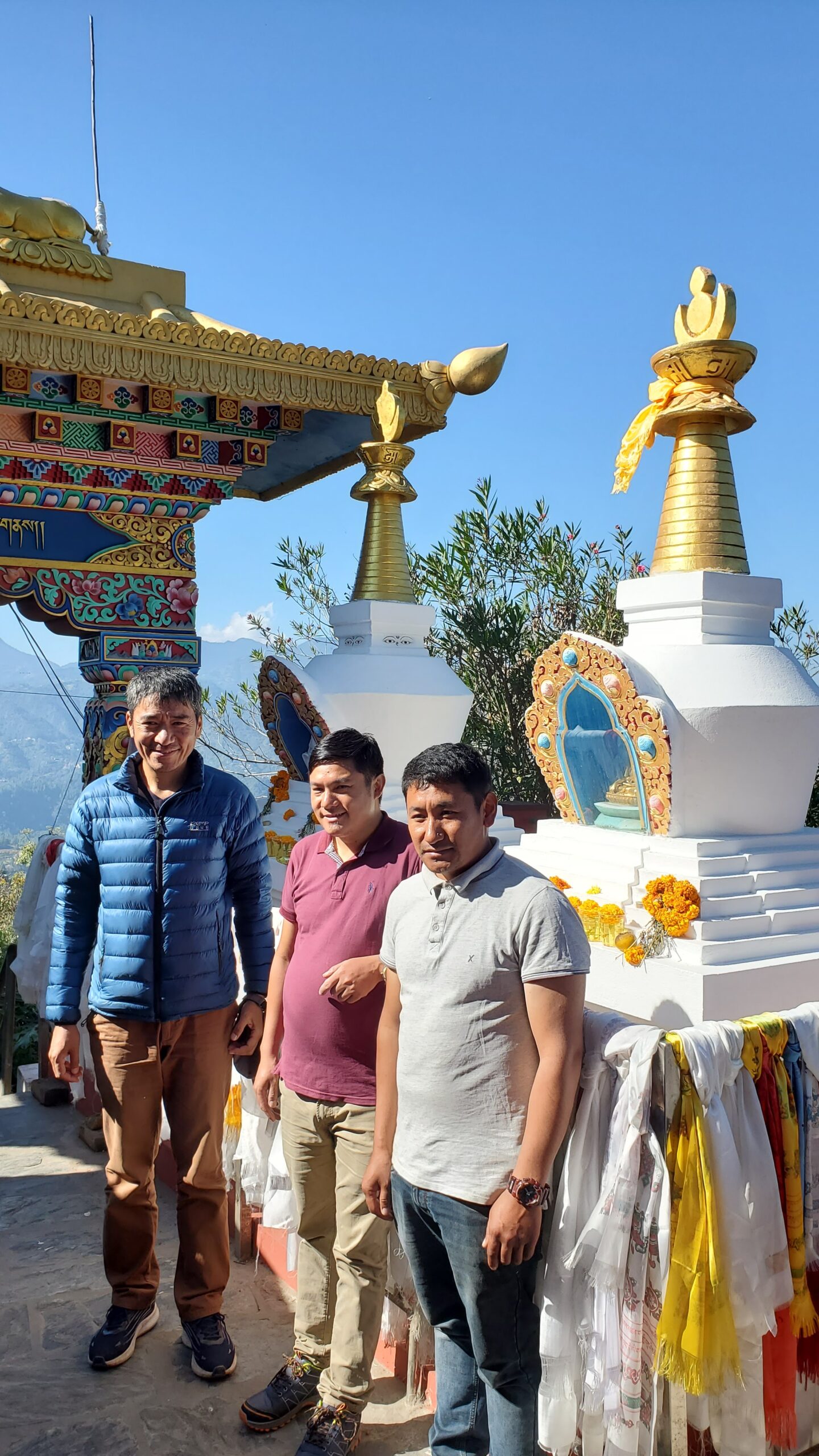
Amber and Mani Tamang, are the founder and manager respectively of Three Jewels Adventures. Amber and his wife, Sushma founded Three Jewels in 2001 as a family business with a social contract. Traveliing that is sustainable and eco-friendly is of central importance to the Three Jewels’ team. Amber has had more than 30 years experience in the field and commenced working on treks as a law student. He specialises in guiding regular trekking to Buddhist and Hindu cultural and archaeological sites.
Mani was born in the Solukhumbu region and is a Business Studies and Information Technology graduate. He has been in the field for 15+ years. Both of these experienced and skilled personnel provide the backbone of our support and logistical team. In addition Amber has added a Ladakhi cultural specialist to the contingent.
The FPMT in Australia’s National Education Coordinator is the pilgrimage coordinator, and together with Amber, Mani and our Ladakhi specialist, will ensure pilgrims’ safety, wellbeing and happiness. To the left is a photo of Amber, Mani and the wonderful Nursang at our FPMTA pilgrimage with Geshe Tenzin Zopa in November 2023.

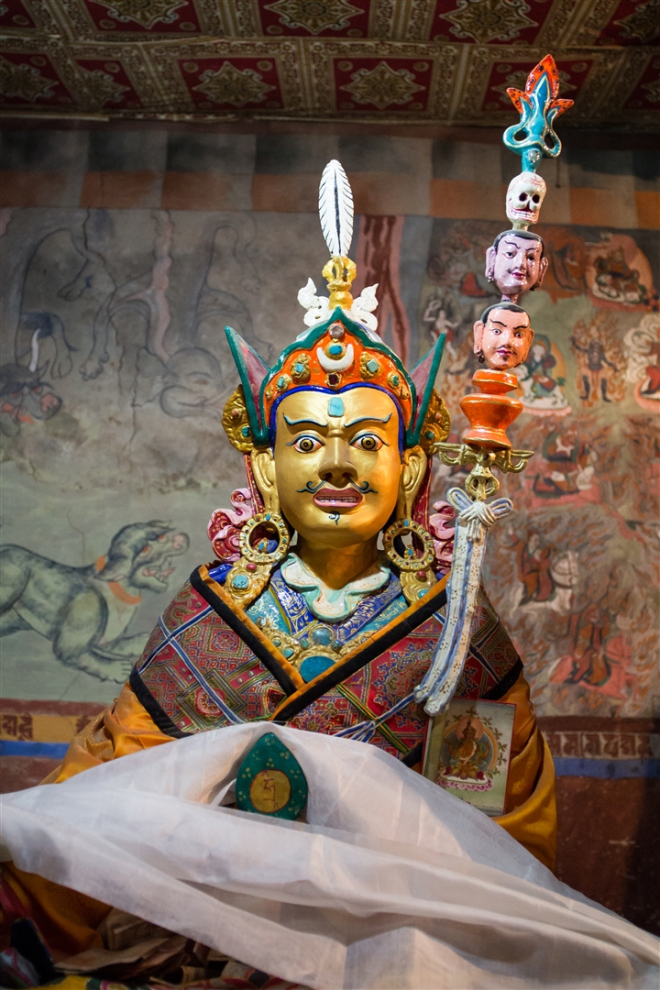

FPMT in Australia acknowledges the Traditional Custodians of the lands upon which we work and live. We pay our respects to Elders, past, present and future, as well as all Aboriginal and Torres Strait Islander peoples – their Country, Culture, and Community.
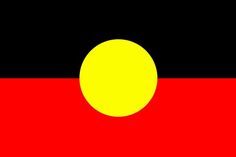
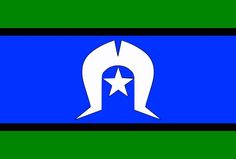
1. Following us on Instagram
2. Following us on Facebook
3. Subscribing to our YouTube channel
Thank you so much!
© 2024 Created by FPMTA Communications with Seedprod